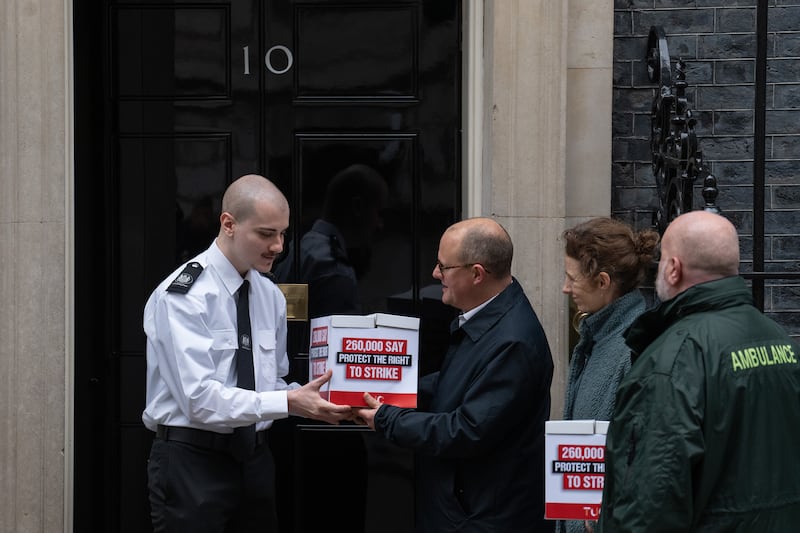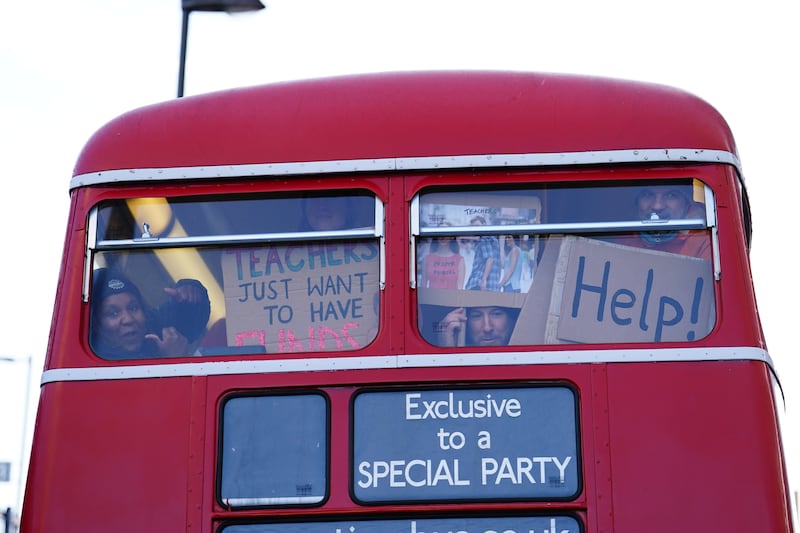It was 8am and a chilly five degrees on the picket line at Bishop Thomas Grant Catholic school in Streatham, south London, as National Education Union (NEU) co-leader Mary Bousted explained to assembled media why the teachers were out in the cold instead of inside the classroom.
The crowd parted and an older man in a vintage Riley car pulled up. He raised a clenched fist in mock triumph, dangled a rolled up cigarette from his lip and cranked up the stereo. With his glinted eye and cheeky grin, he looked remarkably like Bill Nighy’s ageing rocker in Love Actually.
“Who the hell is that?” murmured a reporter, as the new arrival stole Bousted’s thunder. He identified himself as John Shaw, a former art teacher and retired 40-year veteran of the school, who wanted to support his younger colleagues. Things were rarely as bad in his day, he said.
Shaw’s theatrical entry encapsulated the free-period giddiness at the start of the teachers’ strikes across England and Wales on Walkout Wednesday, the biggest strikes in Britain in more than a decade and the closest to a general strike since the 1980s.
READ MORE
About 500,000 mostly public sector workers from seven unions arranged co-ordinated action to put pressure on Rishi Sunak’s government to fund large increases to combat the cost-of-living crisis. For months ministers have resisted, citing strained public finances.
About 200,000 teachers were joined by 100,000 civil servants, 70,000 university lecturers, most bus drivers and rail staff, who have been striking intermittently since last summer. Health workers go out again next week. The cauldron of industrial strife is bubbling in high-tension, low-growth Britain.

Natasha De Stefano-Honey has been a history teacher for 14 years: “The last couple have been the worst of my career.”
She said teachers are overworked and underpaid, while staff numbers and morale are low. She attributed the problems to close to 13 years of low or no pay rises since the last big crash. They got an increase of 5 per cent last year but schools had to fund it from existing budgets.
Teachers claim to have had an effective one-fifth cut in the spending power of their salaries since 2010. The cost-of-living crisis, with inflation peaking at 11 per cent recently, brought it to a head. More strikes are pencilled in later this month. De Stefano-Honey is ready.
“I easily do a 12-hour day most days. Sometimes I come in so early, I have to get the night bus into work. I’m constantly exhausted. I love this job but we will keep striking. We won’t give up.”
The school’s head of history and politics, Jeremy Taylor, said “teachers are now standing up for themselves”. They want a rise to match inflation, which means a double-digit percentage increase.
“Most teachers I know do 60 hours per week in term time. The staff car park here is usually full at 7.30am and if you come in at 5.30am, there will be teachers parked there already.”
Taylor said the disparate disputes, from ambulance drivers to rail staff, are all linked: “They should not be seen as separate. Working people are fed up in this country after years of real pay cuts.”
More than half of schools were fully or partially shut on Wednesday. Meanwhile, almost no trains ran across Britain, as RMT and Aslef members, who have been offered 8 per cent, walked out once again. The gates at Victoria Station, where trains normally run to Gatwick airport, were locked.
Picketing drivers outside said they weren’t allowed speak on the record to media. But their frustration was made clear, as was their wish that Sunak’s Conservative government would fall.

Closer to Westminster, bemused tourists wandering along Horse Guards Road were greeted by a Public and Commercial Services (PCS) union picket on the steps of the Treasury building, where inside the purse strings are being held tightly. Other striking PCS workers at Britain’s borders disrupted arrivals into the country.
Ellie Clarke, a PCS member who works as an administrator in the cabinet office, said her colleagues are angry at the 2 per cent rise offered to civil servants.
“It’s so scary. Not a day goes by that I don’t worry about money. My rent is half my salary. That’s before I even think about other bills such as gas. I’m one crisis away from having to make really horrible decisions. Will I be homeless? What if something happens to my cat? Can I pay the vet?”
Shortly before lunchtime the various strikers and their supporters assembled at Portland Place near BBC Broadcasting House. The crowd swelled beyond 100,000 and marched through London’s commercial heartland of the West End, before congregating for a noisy rally in Whitehall.
Speaker after speaker implored the strikers to stay the distance, as the government tries to drag out the disputes until inflation lowers. The crowd, by now in carnival atmosphere, roared their approval. They massed at the end of Downing Street. Sunak, in Number 10, must have heard them. Whether he heeds them is another matter, as the government struggles to repair Britain’s battered finances.














